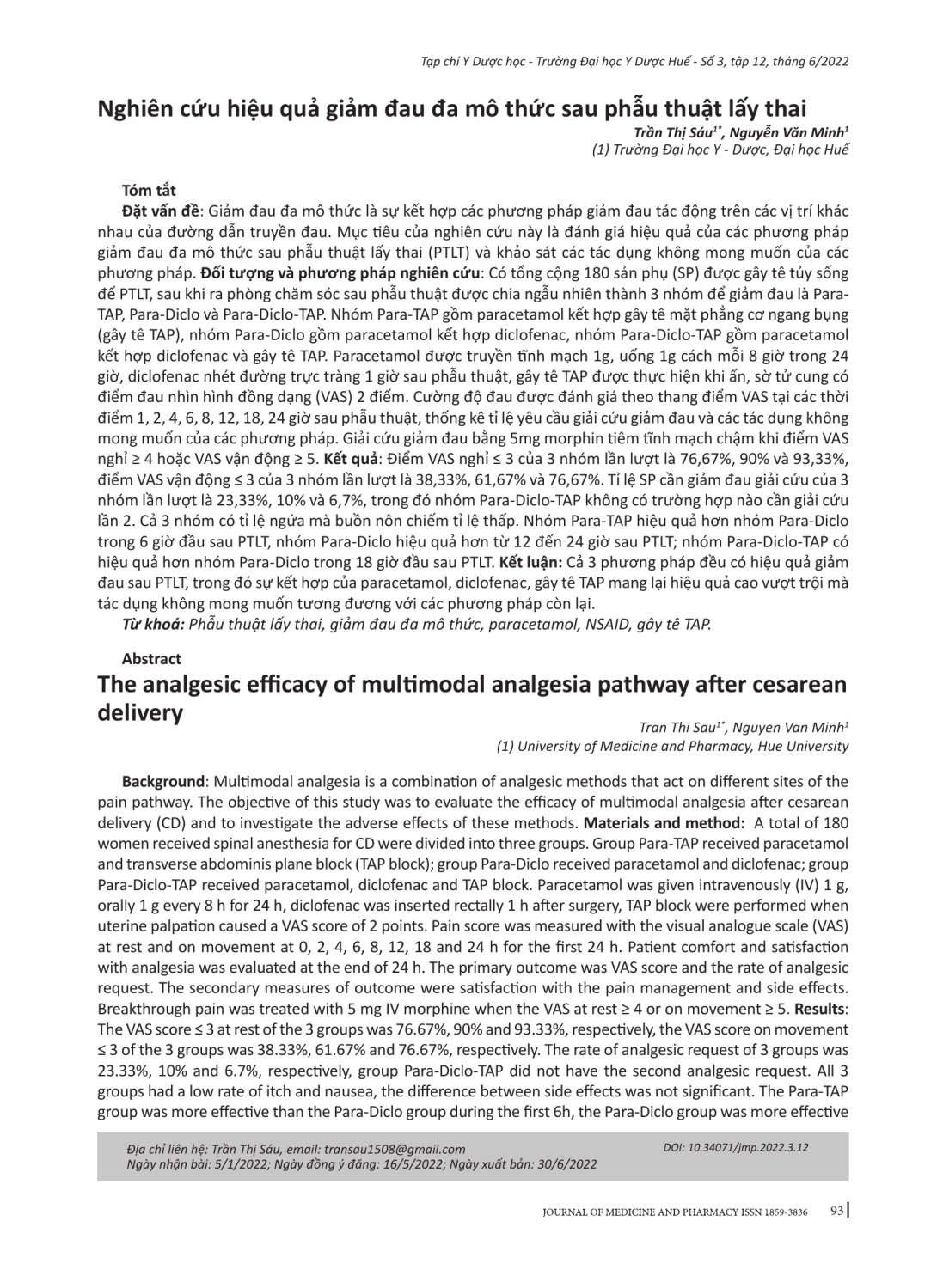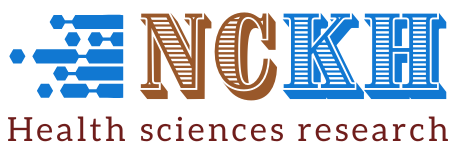
Đánh giá hiệu quả của các phương pháp giảm đau đa mô thức sau phẫu thuật lấy thai (PTLT) và khảo sát các tác dụng không mong muốn của các phương pháp. Đối tượng và phương pháp nghiên cứu: Có tổng cộng 180 sản phụ (SP) được gây tê tủy sống để PTLT, sau khi ra phòng chăm sóc sau phẫu thuật được chia ngẫu nhiên thành 3 nhóm để giảm đau là Para- TAP, Para-Diclo và Para-Diclo-TAP. Nhóm Para-TAP gồm paracetamol kết hợp gây tê mặt phẳng cơ ngang bụng (gây tê TAP), nhóm Para-Diclo gồm paracetamol kết hợp diclofenac, nhóm Para-Diclo-TAP gồm paracetamol kết hợp diclofenac và gây tê TAP. Paracetamol được truyền tĩnh mạch 1g, uống 1g cách mỗi 8 giờ trong 24 giờ, diclofenac nhét đường trực tràng 1 giờ sau phẫu thuật, gây tê TAP được thực hiện khi ấn, sờ tử cung có điểm đau nhìn hình đồng dạng (VAS) 2 điểm. Cường độ đau được đánh giá theo thang điểm VAS tại các thời điểm 1, 2, 4, 6, 8, 12, 18, 24 giờ sau phẫu thuật, thống kê tỉ lệ yêu cầu giải cứu giảm đau và các tác dụng không mong muốn của các phương pháp. Giải cứu giảm đau bằng 5mg morphin tiêm tĩnh mạch chậm khi điểm VAS nghỉ ≥ 4 hoặc VAS vận động ≥ 5. Kết quả: Điểm VAS nghỉ ≤ 3 của 3 nhóm lần lượt là 76,67%, 90% và 93,33%, điểm VAS vận động ≤ 3 của 3 nhóm lần lượt là 38,33%, 61,67% và 76,67%. Tỉ lệ SP cần giảm đau giải cứu của 3 nhóm lần lượt là 23,33%, 10% và 6,7%, trong đó nhóm Para-Diclo-TAP không có trường hợp nào cần giải cứu lần 2. Cả 3 nhóm có tỉ lệ ngứa mà buồn nôn chiếm tỉ lệ thấp. Nhóm Para-TAP hiệu quả hơn nhóm Para-Diclo trong 6 giờ đầu sau PTLT, nhóm Para-Diclo hiệu quả hơn từ 12 đến 24 giờ sau PTLT; nhóm Para-Diclo-TAP có hiệu quả hơn nhóm Para-Diclo trong 18 giờ đầu sau PTLT. Kết luận: Cả 3 phương pháp đều có hiệu quả giảm đau sau PTLT, trong đó sự kết hợp của paracetamol, diclofenac, gây tê TAP mang lại hiệu quả cao vượt trội mà tác dụng không mong muốn tương đương với các phương pháp còn lại.
Multimodal analgesia is a combination of analgesic methods that act on different sites of the pain pathway. The objective of this study was to evaluate the efficacy of multimodal analgesia after cesarean delivery (CD) and to investigate the adverse effects of these methods. Materials and method: A total of 180 women received spinal anesthesia for CD were divided into three groups. Group Para-TAP received paracetamol and transverse abdominis plane block (TAP block); group Para-Diclo received paracetamol and diclofenac; group Para-Diclo-TAP received paracetamol, diclofenac and TAP block. Paracetamol was given intravenously (IV) 1 g, orally 1 g every 8 h for 24 h, diclofenac was inserted rectally 1 h after surgery, TAP block were performed when uterine palpation caused a VAS score of 2 points. Pain score was measured with the visual analogue scale (VAS) at rest and on movement at 0, 2, 4, 6, 8, 12, 18 and 24 h for the first 24 h. Patient comfort and satisfaction with analgesia was evaluated at the end of 24 h. The primary outcome was VAS score and the rate of analgesic request. The secondary measures of outcome were satisfaction with the pain management and side effects. Breakthrough pain was treated with 5 mg IV morphine when the VAS at rest ≥ 4 or on movement ≥ 5. Results: The VAS score ≤ 3 at rest of the 3 groups was 76.67%, 90% and 93.33%, respectively, the VAS score on movement ≤ 3 of the 3 groups was 38.33%, 61.67% and 76.67%, respectively. The rate of analgesic request of 3 groups was 23.33%, 10% and 6.7%, respectively, group Para-Diclo-TAP did not have the second analgesic request. All 3 groups had a low rate of itch and nausea, the difference between side effects was not significant. The Para-TAP group was more effective than the Para-Diclo group during the first 6h, the Para-Diclo group was more effective during 12-24 h period, the Para-Diclo-TAP group was more effective than the Para-Diclo group for a period of 18h. Conclusion: All 3 methods are effective in pain relief after CD, in which the combination of paracetamol, diclofenac, and TAP block brings outstanding efficiency but side effects are equivalent to other methods.
- Đăng nhập để gửi ý kiến
